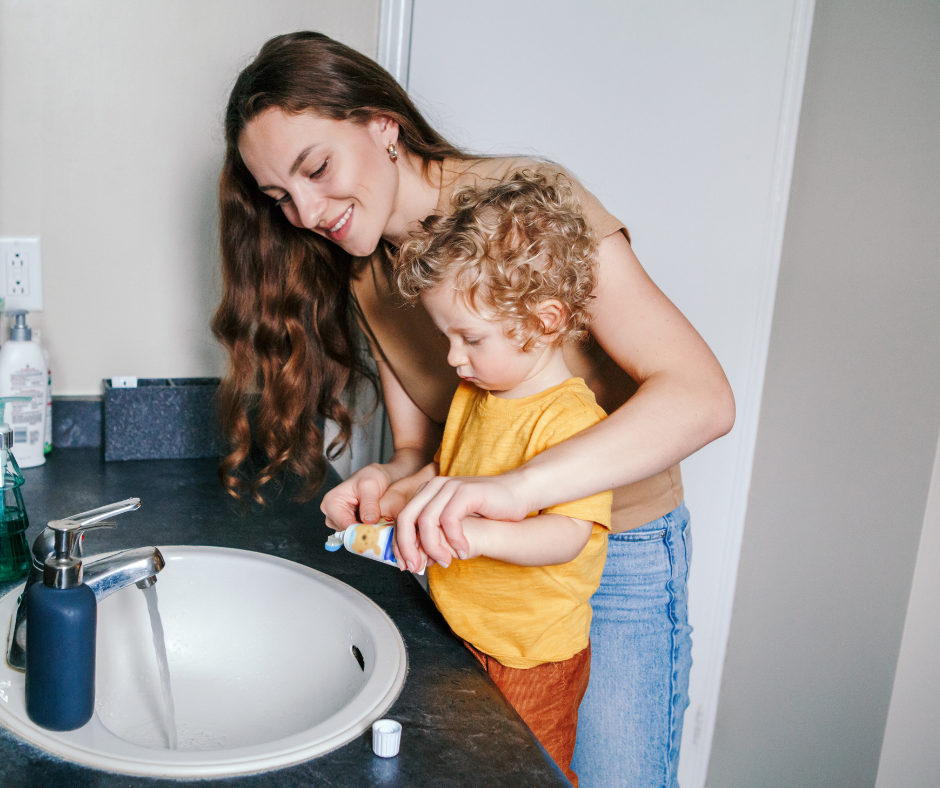Toothbrushing should start as soon as your child’s teeth begin to come in in order to maintain ideal infant oral care. Most children begin to get their first teeth around 6 months of age, which makes them much too young to properly brush their teeth on their own. As the parent, your child’s oral hygiene habits will fall to you during their early years.
It’s important to learn how to brush your child’s teeth properly until they are old enough to do it on their own. Here are some tips to help you keep your child’s teeth healthy until they’re old enough to brush on their own.
Pick the Right Toothbrush
It can seem like all toothbrushes are created equal, but that’s not true. When choosing a toothbrush for your child, there are actually several factors to take into account.
Choose a toothbrush with soft bristles. Medium or hard bristles can irritate your child’s sensitive gums. Soft bristles clean teeth just as effectively as harder bristles. Avoid buying a toothbrush that has any added rubber bristles. These don’t actually add any cleaning efficacy and can actually cut your child’s gums.
Since your child’s mouth is much smaller than yours, look for a toothbrush with a smaller head. The head should be able to fit comfortably between your child’s teeth and gums. It can be helpful to bring your child along while you shop, so you can get a better idea of what size toothbrush will work best.
You should replace your child’s toothbrush every three months or when the bristles begin to fray, whichever occurs first. Once you have the right toothbrush for the job, you can then focus on how to brush your child’s teeth.
4 Steps for Proper Teeth Brushing
If your child is still too young to brush their teeth themselves, the parent should brush their teeth for them. The following steps explain how to brush your child’s teeth:
- Step 1: Angle the toothbrush at 45 degrees towards the gums of the upper and lower teeth.
- Step 2: Move the toothbrush gently back and forth with short strokes along the teeth and gums. Continue to move the toothbrush along the inner and outer surfaces of every tooth.
- Step 3: Place the tip of the brush in an upright position to reach behind the front teeth along the top and bottom of the jaw,
- Step 4: Brush the tongue to remove bacteria.
You should brush your child’s teeth twice a day for two minutes each time.
For children who are younger than two years old, using toothpaste is not recommended since they don’t yet have the ability to spit it out. During this time, brushing their teeth with just a toothbrush and water will suffice.
Children can usually start using fluoridated toothpaste at age two, but it’s best to discuss this with your child’s dentist. When you do start using toothpaste, a pea-sized amount is all you need. Since children can be sensitive to strong flavors, it can be helpful to find toothpaste in more kid-friendly flavors than mint. Look for toothpaste with bubble gum or fruit flavors, and let your child test out the flavor before brushing.
How to Tell if Your Child Can Brush on Their Own
As your child gets older, they will be able to take on the responsibility of brushing their own teeth. There are seven signs that can indicate that your child is ready to brush on their own:
- Your child is between the ages of 6 to 9. While the actual age varies for each child, children typically learn to brush their own teeth within this age range.
- Your child can tie their shoelaces. Like toothbrushing, tying shoelaces requires a high level of manual dexterity. If your child has mastered shoelaces, they likely possess the manual dexterity needed to brush their teeth properly, too.
- Your child does their homework and chores on their own. When your child starts taking personal responsibility for things in their life like doing their homework without being told and completing chores, it may mean that they’re ready for the responsibility of teeth brushing.
- Your child can write in cursive. Writing in cursive requires a mastery of fine motor skills. If your child can write well in cursive, they will have no problem navigating toothbrushing.
- Your child practices good hygiene. If your child has mastered other personal hygiene habits like showering and brushing their hair, they are probably ready to tackle toothbrushing.
- Your child passes the plaque tablet test. You can have your child chew a plaque disclosing tablet, which will turn all of the plaque on their teeth into a bright color. If they’re able to brush their teeth and get all of the plaque, you’ll know that they’re ready to brush on their own.
- Your child passes the parent test. You can observe your child while they brush to make sure they’re using the right technique. Once you feel confident with your child’s brushing abilities, you can let them handle it on their own.
Once you’re confident that your child can brush their teeth on their own, you should still make sure to give your child reminders to brush twice a day. Eventually they won’t need to be reminded, but it’s best to remind them when they’re first starting to brush on their own.
Making sure you know how to brush your child’s teeth is an important part of your child’s early oral hygiene habits. Until they’re old enough to brush on their own, it’s up to you, the parent, to make sure that they’re teeth are getting properly cleaned to avoid more serious issues, such as cavities that would require composite fillings. Once they get their first tooth, that also means it’s time to make their first dentist appointment. To make an appointment or for any further questions on toothbrushing, contact Children’s Dentistry today.

